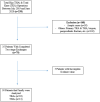The change in plasma D-dimer does not help to guide the timing of reimplantation in two stage exchange for periprosthetic joint infection
- PMID: 33795812
- PMCID: PMC8016946
- DOI: 10.1038/s41598-021-86890-z
The change in plasma D-dimer does not help to guide the timing of reimplantation in two stage exchange for periprosthetic joint infection
Abstract
D-dimer has been included in the criteria by the Musculoskeletal Infection Society in 2018 as a novel parameter to diagnose prosthetic joint infection (PJI). However, it is unclear how D-dimer levels change in between stages of a two-stage exchange. We prospectively investigated 30 patients who underwent a two-stage exchange using a spacer for PJI. D-Dimer, CRP and IL-6 were collected before first and second stage surgery and the difference (Δ) in between stages was calculated. The levels of plasma D-Dimer did not change from first to second stage surgery (2770 ng/ml (IQR, 1600-3770 ng/ml) versus 2340 ng/ml (IQR, 1270-4100 ng/ml); p = 0.8) while CRP (4.0 mg/dl (IQR, 1.7-5.5 mg/dl) versus 0.6 mg/dl (IQR, 0.5-0.8 mg/dl); p < 0.001) and IL-6 (21 pg/ml (IQR, 10-29 pg/ml) versus 6 pg/ml (4-9 pg/ml); p < 0.001) decreased. The ΔD-dimer between both stages was 300 ng/ml (range: - 2820 to 4280 ng/ml), the median ΔCRP was - 3.4 mg/dl (IQR, - 1.2 to - 4.8 mg/dl) and ΔIL-6 was - 13 pg/ml (IQR, - 4 to - 20 pg/ml). In 15 of 30 cases (50%) the D-dimer level increased between both stages, whereas the level of CRP (93%; 28/30) and IL-6 (96%; 28/29) decreased in most patients. As the level of serum D-dimers varies greatly, lacks a uniform decrease and does not identify persisting infection, surgeons should be cautious when using it at the timing of reimplantation.
Conflict of interest statement
The authors declare no competing interests.
Figures
Similar articles
-
Serum D-Dimer Test Is Promising for the Diagnosis of Periprosthetic Joint Infection and Timing of Reimplantation.J Bone Joint Surg Am. 2017 Sep 6;99(17):1419-1427. doi: 10.2106/JBJS.16.01395. J Bone Joint Surg Am. 2017. PMID: 28872523
-
Does Change in ESR and CRP Guide the Timing of Two-stage Arthroplasty Reimplantation?Clin Orthop Relat Res. 2019 Feb;477(2):364-371. doi: 10.1097/01.blo.0000533618.31937.45. Clin Orthop Relat Res. 2019. PMID: 30566107 Free PMC article.
-
Comparison of D-dimer with CRP and ESR for diagnosis of periprosthetic joint infection.J Orthop Surg Res. 2019 Jul 29;14(1):240. doi: 10.1186/s13018-019-1282-y. J Orthop Surg Res. 2019. PMID: 31358018 Free PMC article.
-
What Markers Best Guide the Timing of Reimplantation in Two-stage Exchange Arthroplasty for PJI? A Systematic Review and Meta-analysis.Clin Orthop Relat Res. 2018 Oct;476(10):1972-1983. doi: 10.1097/01.blo.0000534680.87622.43. Clin Orthop Relat Res. 2018. PMID: 30794241 Free PMC article.
-
[Comparison of therapeutic strategies for hip and knee prosthetic joint infection].Acta Chir Orthop Traumatol Cech. 2009 Aug;76(4):302-9. Acta Chir Orthop Traumatol Cech. 2009. PMID: 19755054 Review. Czech.
Cited by
-
Comparable clinical outcomes of culture-negative and culture-positive periprosthetic joint infections: a systematic review and meta-analysis.J Orthop Surg Res. 2023 Mar 16;18(1):210. doi: 10.1186/s13018-023-03692-x. J Orthop Surg Res. 2023. PMID: 36927390 Free PMC article.
-
Interval between two-stage exchanges: what is optimal and how do you know?Arthroplasty. 2023 Jul 5;5(1):33. doi: 10.1186/s42836-023-00185-4. Arthroplasty. 2023. PMID: 37403130 Free PMC article. Review.
References
MeSH terms
Substances
LinkOut - more resources
Full Text Sources
Other Literature Sources
Medical
Research Materials
Miscellaneous


